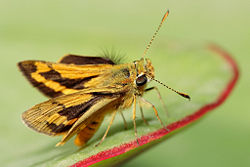Skipper (butterfly)
| Skipper Butterfly | ||||||||||||||
|---|---|---|---|---|---|---|---|---|---|---|---|---|---|---|
 Green Grass-Dart Skipper Butterfly, Ocybadistes walkeri
| ||||||||||||||
| Scientific classification | ||||||||||||||
| ||||||||||||||
| Diversity | ||||||||||||||
| About 550 genera, 3,500 species | ||||||||||||||
|
Coeliadinae |
A skipper is a butterfly of the family Hesperiidae (superfamily Hesperioidea), named after their quick, darting flight habits. There are more than 3500 recognized species of skippers and they occur worldwide,but with the greatest diversity occurring in the tropical regions of Central and South America.
Skippers differ in several important ways from the remaining butterflies, which are classified in the superfamily Papilionoidea and the neotropical superfamily Hedyloidea. Collectively, these three groups of butterflies share several characteristics especially in the egg, larval and pupal stage (Ackery et al. 1999). However, skippers have the antennae clubs hooked backward like a crochet hook, whilst butterflies have club-like tips to their antennae and hedylids have feathered or pectinate antennae giving them an even more moth-like appearance than skippers. Skippers also have generally stockier bodies than the other two groups, with stronger wing muscles. Hesperioidea is very likely the sister group of Papilionoidea, and together with Hedyloidea constitute a natural group or clade.
There are about 3500 species of Skippers. They are usually classified in the following subfamilies:
- Awls, Awlets and Policemen (Subfamily Coeliadinae, about 75 species)
- Grass Skippers (Subfamily Hesperiinae, over 2000 species)
- Skipperlings (Subfamily Heteropterinae, about 150 species)
- Giant Skippers (Subfamily Megathyminae, about 100 species)
- Spread-winged Skippers (Subfamily Pyrginae, about 1000 species)
- Firetips (Subfamily Pyrrhopyginae, about 150 species)
- Australian Skippers (Subfamily Trapezitinae, about 60 species)
A phylogeny of the families based on DNA sequence data.[1] |
Note: Some authorities treat the Giant Skippers as a separate family, the Megathymidae, but more modern classifications place them within the subfamily Hesperiinae in the family Hesperiidae.
Many species of skippers look frustratingly alike. For example, some species in the genera Erynnis, Hesperia, and Amblyscirtes cannot currently be distinguished in the field by experts, the only reliable method of telling them apart involving dissection and examination of the genitalia.
Notes
- ↑ Warren A, Ogawa J, Brower A. (2008) Phylogenetic relationships of subfamilies and circumscription of tribes in the family Hesperiidae (Lepidoptera: Hesperioidea). Cladistics 24(5):642-676
ReferencesISBN links support NWE through referral fees
- Ackery, P.R., de Jong, R and Vane-Wright, R.I. (1999). The Butterflies: Hedyloidea, Hesperioidea and Papilionoidae. Pp. 263-300 in Kristensen, N.P. (Ed.). Lepidoptera, Moths and Butterflies. Volume 1: Evolution, Systematics, and Biogeography. Handbuch der Zoologie. Eine Naturgeschichte der Stämme des Tierreiches / Handbook of Zoology. A Natural History of the phyla of the Animal Kingdom. Band / Volume IV Arthropoda: Insecta Teilband / Part 35: 491 pp. Walter de Gruyter, Berlin, New York.
External links
- Nearctica North America (Index page)
- Skippers of North America: Large format diagnostic photographs Cirrus Digital Imaging
- Tree of Life Hesperiidae
- bean leafroller on the UF / IFAS Featured Creatures Web site
- Megathymus yuccae, yucca giant-skipper on the UF / IFAS Featured Creatures Web site
- Epargyreus clarus, silver-spotted skipper on the UF / IFAS Featured Creatures Web site
- Internet Archive Free downlad of Watson, E.Y. 1891 Hesperiidae Indicae : being a reprint of descriptions of the Hesperiidae of India, Burma, and Ceylon
| |||||||||||||||||||||||||||
Credits
New World Encyclopedia writers and editors rewrote and completed the Wikipedia article in accordance with New World Encyclopedia standards. This article abides by terms of the Creative Commons CC-by-sa 3.0 License (CC-by-sa), which may be used and disseminated with proper attribution. Credit is due under the terms of this license that can reference both the New World Encyclopedia contributors and the selfless volunteer contributors of the Wikimedia Foundation. To cite this article click here for a list of acceptable citing formats.The history of earlier contributions by wikipedians is accessible to researchers here:
The history of this article since it was imported to New World Encyclopedia:
Note: Some restrictions may apply to use of individual images which are separately licensed.